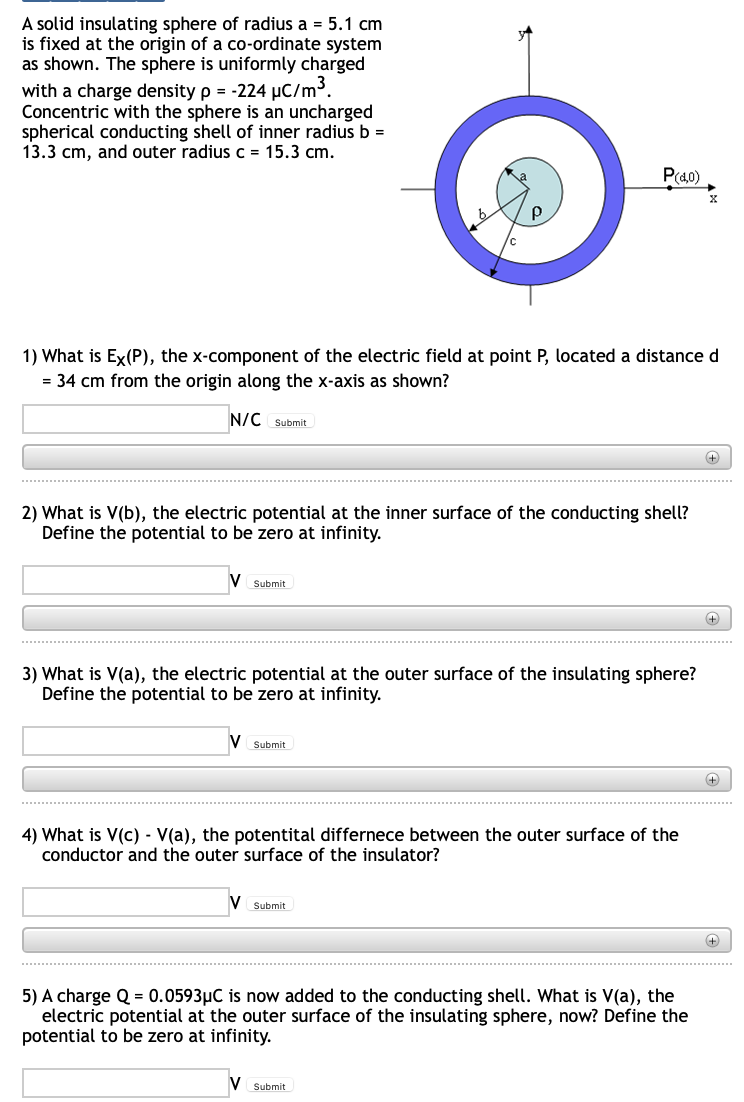A solid insulating sphere of radius a = 5.1 cm is fixed at the origin of a co-ordinate system as shown. The sphere is uniformly charged with a charge density p = -224 µC/m³. Concentric with the sphere is an uncharged spherical conducting shell of inner radius b = 13.3 cm, and outer radius c = 15.3 cm. P(40) 1) What is Ex(P), the x-component of the electric field at point P, located a distance d = 34 cm from the origin along the x-axis as shown? N/C Submit 2) What is V(b), the electric potential at the inner surface of the conducting shell? Define the potential to be zero at infinity. V Submit 3) What is V(a), the electric potential at the outer surface of the insulating sphere? Define the potential to be zero at infinity.
A solid insulating sphere of radius a = 5.1 cm is fixed at the origin of a co-ordinate system as shown. The sphere is uniformly charged with a charge density p = -224 µC/m³. Concentric with the sphere is an uncharged spherical conducting shell of inner radius b = 13.3 cm, and outer radius c = 15.3 cm. P(40) 1) What is Ex(P), the x-component of the electric field at point P, located a distance d = 34 cm from the origin along the x-axis as shown? N/C Submit 2) What is V(b), the electric potential at the inner surface of the conducting shell? Define the potential to be zero at infinity. V Submit 3) What is V(a), the electric potential at the outer surface of the insulating sphere? Define the potential to be zero at infinity.
Chapter6: Gauss's Law
Section: Chapter Questions
Problem 52P: A long copper cylindrical shell of inner radius 2 cm and outer radius 3 cm surrounds concentrically...
Related questions
Question

Transcribed Image Text:A solid insulating sphere of radius a = 5.1 cm
is fixed at the origin of a co-ordinate system
as shown. The sphere is uniformly charged
with a charge density p = -224 µC/m³.
Concentric with the sphere is an uncharged
spherical conducting shell of inner radius b =
13.3 cm, and outer radius c = 15.3 cm.
P(40)
1) What is Ex(P), the x-component of the electric field at point P, located a distance d
= 34 cm from the origin along the x-axis as shown?
N/C Submit
+
2) What is V(b), the electric potential at the inner surface of the conducting shell?
Define the potential to be zero at infinity.
V Submit
+)
3) What is V(a), the electric potential at the outer surface of the insulating sphere?
Define the potential to be zero at infinity.
Submit
4) What is V(c) - V(a), the potentital differnece between the outer surface of the
conductor and the outer surface of the insulator?
Submit
5) A charge Q = 0.0593µC is now added to the conducting shell. What is V(a), the
electric potential at the outer surface of the insulating sphere, now? Define the
potential to be zero at infinity.
V Submit
Expert Solution
This question has been solved!
Explore an expertly crafted, step-by-step solution for a thorough understanding of key concepts.
This is a popular solution!
Trending now
This is a popular solution!
Step by step
Solved in 4 steps

Knowledge Booster
Learn more about
Need a deep-dive on the concept behind this application? Look no further. Learn more about this topic, physics and related others by exploring similar questions and additional content below.Recommended textbooks for you


Principles of Physics: A Calculus-Based Text
Physics
ISBN:
9781133104261
Author:
Raymond A. Serway, John W. Jewett
Publisher:
Cengage Learning

Physics for Scientists and Engineers: Foundations…
Physics
ISBN:
9781133939146
Author:
Katz, Debora M.
Publisher:
Cengage Learning


Principles of Physics: A Calculus-Based Text
Physics
ISBN:
9781133104261
Author:
Raymond A. Serway, John W. Jewett
Publisher:
Cengage Learning

Physics for Scientists and Engineers: Foundations…
Physics
ISBN:
9781133939146
Author:
Katz, Debora M.
Publisher:
Cengage Learning